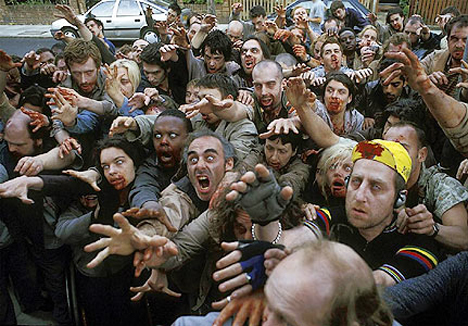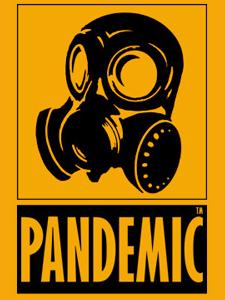Tag Archives: zombie
Awesome Homemade Zombie Apocalypse Killing Weapons
When the end comes eventually bullets will run out. Don’t toss your guns aside cause ya never know if and when you may run across a stash of ammo..but one thing is for sure…you will still have to protect yourself and those with you..so i present to you some of the best ideas to keep you swinging in the Z-POC







ZOMBIE FURNITURE WTF
Looking for furniture that will both tie the room together and make your guests gag with fear?
BRC Designs probably has what you’re looking for. The razor-sharp minds over at the design house, based in Spartanburg, South Carolina, have unleashed a terrible plague upon the world of home decor: “zombie furniture.” These are seats and couches with dripping blood, raw patches that look like skin was torn off and a general appearance of getting ready to animate itself and shuffle over to eat your flesh. And the horror of this festering line doesn’t end there, with its origin stretching all the way over the ocean to Ghana’s famous carpenters of death.
An Xiao Mina at Core77 has the full story of how this sleep-disturbing (yet swanky!) stuff got made, but here’s the short version. BRC chief Benjamin Caldwell traveled to Ghana to apprentice with the country’s coffin builders, who produce unique boxes meant to reflect the lifestyle and accomplishments of the deceased. Picking up a plane and chisel, Caldwell settled in with Eric Anang, grandson of the renowned artisan Kane Kwei, whose studio has churned out coffins in the guise of red fish, flashy cars and, weirdly, a pig for the businessman who introduced swine to Accra.

Once he’d honed his skills, Caldwell then got around to creating his own monsters. His team digs holes in the dirt to create molds for wet concrete, which they pour in and then abandon in the ground for 30 days. (Some people in Ghana are buried in a soft bed of concrete, FYI.) After the month is up and the material has developed a little “character,” they pry it out and use it as the base for furniture.
Here’s where it gets raw, reports Mina:
To top it off, they stain the pieces with acid, itself a variable process, to create a deathly, out-from-the-grave feel. They focused on the rough patches in particular: “We stained these areas with a dull black and brown as if rotting flesh and then we dripped glossy red stain over the area creating the appearance of an oozing, rotten wound.” This variance keeps with the zombie theme but also contrasts sharply with the necessary precision of coffin-making….
“The first person who saw it said ‘It looks like someone died on this chair.'”
The name that Caldwell picked for his blood-soaked line? That would be “Risen in 30 Days,” a riff on the furniture’s resurrection from its soil jail.
While it may cause some people to curl into fetal positions, the furniture is indisputably original and kind of intriguing, like being at the scene of a gruesome murder. And to give it a positive spin, it won’t leave a wet spot on your pants or dress should you sit on it, like a real rotting carcass might.
I don’t see any prices listed for the “zombie chaise lounge” or “zombie sofa,” so you’ll want to hithim up on email if you want one of these stunners. Also available in the BRC catalog are less-abominable offerings, such as this chair made from old piano hammers and a seat called “Impractically Comfortable” containing 282 mini bottles of Southern Comfort. Arachnophobes, however, will hate the “Spider” line of furniture, with its multiple spindly legs and black hairlike backing.
All photos courtesy of BRC Designs.


Zombie apocalypse prophesied in ancient scriptures
 In recent headlines, there have been outbreaks of bizarre, brutal, cannibalistic events that have unfolded over the past few weeks, with an almost daily occurrence of articles written about cannibalism and the “Zombie Apocalypse.” There have been disturbing tales of humans devouring fellow humans, from the bath salts incident, involving a nakedcannibal, to the ‘Cannibal Killer,’ a porn star who allegedly murdered, dismembered and tasted the flesh of his victim. Just Saturday, many newspapers even reported the stomach contents of the Miami cannibal/zombie. Stores are beginning to carry zombie bullets, and college dorms are beginning to hold zombie drills, so students will be prepared for the hoards of zombies that could possibly attack mankind. Unfortunately, all of these stories seem perfectly suited to for horror films, but are real.
In recent headlines, there have been outbreaks of bizarre, brutal, cannibalistic events that have unfolded over the past few weeks, with an almost daily occurrence of articles written about cannibalism and the “Zombie Apocalypse.” There have been disturbing tales of humans devouring fellow humans, from the bath salts incident, involving a nakedcannibal, to the ‘Cannibal Killer,’ a porn star who allegedly murdered, dismembered and tasted the flesh of his victim. Just Saturday, many newspapers even reported the stomach contents of the Miami cannibal/zombie. Stores are beginning to carry zombie bullets, and college dorms are beginning to hold zombie drills, so students will be prepared for the hoards of zombies that could possibly attack mankind. Unfortunately, all of these stories seem perfectly suited to for horror films, but are real.
Incredibly, though the prospect of zombies and a zombie apocalypse seem purely fiction in the minds of most, the ancient scriptures reveal past, and possibly, future events that significantly resemble zombies or the walking undead. Take for example the death and resurrection narrative of Jesus of Nazareth, though no one would suggest Jesus was a zombie, a portion of the narrative surrounding his death, reveals an incident that most people overlook.
Matt. 27:50-53: And Jesus cried out again with a loud voice, and yielded up His spirit. And behold, the veil of the temple was torn in two from top to bottom; and the earth shook and the rocks were split. The tombs were opened, and many bodies of the saints who had fallen asleep were raised; and coming out of the tombs after His resurrection they entered the holy city and appeared to many.
One could not even imagine what it would have been like to see all of the past saints walk out of their graves, and appear to those dwelling in Jerusalem. Furthermore, one might ask, what actually happened to the bodies of those who were raised? Are they still among us? Or did they die a second time?
A second past event, found within the ancient scriptures, can be found in Ezekiel 37.
Ezekiel 37:7-10: So I prophesied as I was commanded. And as I was prophesying, there was a noise, a rattling sound, and the bones came together, bone to bone. I looked, and tendons and flesh appeared on them and skin covered them…and breath entered them; they came to life and stood up on their feet—a vast army.
Future Zombie Apocalypse
According to certain Christian eschatology, there are two future events that could resemble a zombie apocalypse. The first event, familiar to most, is the resurrection of the dead, in the “last days.” This event is viewed by most, as a time when all the graves of mankind will open, and everyone who has died will come forth for the “final judgment.” In fact, many believe that the dead will be the first judged at the final judgment, and those who are living will witness the event, previous to their judgment. Thus, those who are alive will first witness the dead arising from their graves.
1 Corinthians 15:51- 52: Behold, I shew you a mystery; We shall not all sleep, but we shall all be changed, in a moment, in the twinkling of an eye, at the last trump: for the trumpet shall sound, and the dead shall be raised incorruptible, and we shall be changed.
John 5:28-29: Marvel not at this: for the hour is coming, in the which all that are in the graves shall hear his voice, and shall come forth; they that have done good, unto the resurrection of life; and they that have done evil, unto the resurrection of damnation.
The second eschatological or future event, which could be viewed as a zombie apocalypse, is known by most as the “battle of Armageddon.” It is believed that in the final days, the armies of the devil or Satan, will rise up against God, Israel and God’s army, at a place known as Armageddon. When this occurs, it will appear as if evil has won, throughout the entire earth. At that point, most believe that Jesus will return with all the armies of heaven, to finally defeat the devil and his armies, and cast them into the “lake of fire.”
Revelation 16:12-16 For they are the spirits of devils, working miracles, which go forth unto the kings of the earth and of the whole world, to gather them to the battle of that great day of God Almighty… And he gathered them together into a place called in the Hebrew tongue Armageddon.
Revelation 19:19 And I saw the beast, and the kings of the earth, and their armies, gathered together to make war against him that sat on the horse, and against his army.
Now, there are many scriptures that Christians, which hold this view, use as proof of a future battle. However, one scriptural source, which most have not thoroughly considered, could appear as a massive zombie attack.
Zechariah 14:12-13 And the LORD will send a plague on all the nations that fought against Jerusalem. Their people will become like walking corpses, their flesh rotting away. Their eyes will rot in their sockets, and their tongues will rot in their mouths. On that day they will be terrified, stricken by the LORD with great panic. They will fight their neighbors hand to hand.
Today, most zombie lore revolves around plagues, which cause the dead to rise, and typically battle with or eat the living. This scripture in Zechariah seems to clearly reveal an event, similar to the most recent zombie lore. One might wonder if ancient Christians also feared and imminent zombie attack as well. At the very least, zombie apocalypse fanatics now have a further argument in their arsenal, which points toward a future attack of the undead, found within the ancient scriptures.
ZOMBIE OUTBREAK – Swedish professor eats wife’s lips
 And the zombie apocalypse just keeps on rolling. This time in Sweden an associate professor has given his wife incontrovertible grounds for divorce.
And the zombie apocalypse just keeps on rolling. This time in Sweden an associate professor has given his wife incontrovertible grounds for divorce.
In an apparent attempt to punish the young lady with disfigurement, and to also make it impossible to reattach the lips, the professor cut her lips off, and then ate them. No mention of any fava bean side dishes was made in the English language edition of the article.
“He didn’t want the lips to be able to be sewn back on,” the unnamed source said, explaining why he had eaten them.
The professor has been ordered to endure a psychiatric evaluation. The DSM-IV TR (Diagnostic and Statistical Manual of Mental Disorders) has no code listed for Zombie-ism at BehaveNet, and only obliquely references cannibalism as a form of psychopathology.
Ingela Ekman Hessius, the woman’s lawyer, reports the lady in question as in serious condition and is quoted as saying:
“She is of course not doing well, neither psychologically nor physically,”
Cases of apparent cannibalism have made the news and shocked many around the globe, Rudy Eugene, the Miami Causeway Cannibal, Luka Magnotta with a possible connection to a blog post at Digital Journal, Alexander Kinyua, and perhaps not the most gruesome, but arguably one of the stranger forms was Mao Sugiyamawho had his testicles removed and then cooked and served them to diners.
As for me and my house, I am placing a rush order at my local weapons supply store for at least one box of Zombie Max bullets. The Hornady company notes that the ammunition in question is specifically designed for use on zombies and the disclaimer on the Hornady website is:
Disclaimer: Hornady® Zombie Max™ ammunition is NOT a toy (IT IS LIVE AMMUNITION), but is intended only to be used on…ZOMBIES, also known as the living dead, undead, etc. No human being, plant, animal, vegetable or mineral should ever be shot with Hornady® Zombie Max™ ammunition. Again, we repeat, Hornady® Zombie Max™ ammunition is for use on ZOMBIES ONLY, and that’s not a nickname, phrase or cute way of referring to anybody, place or thing. When we say Zombies, we mean…ZOMBIES!
Read more: http://www.digitaljournal.com/article/326447#ixzz1xUs3Aocf
 said the country was not ready to defend itself against an avian flu pandemic. Have things changed since?
said the country was not ready to defend itself against an avian flu pandemic. Have things changed since?